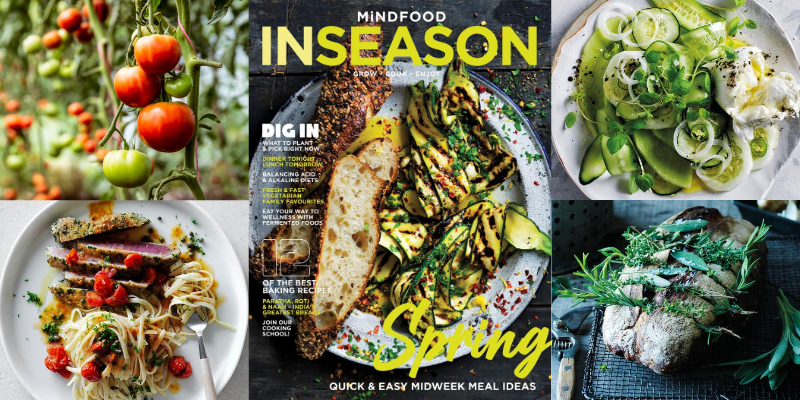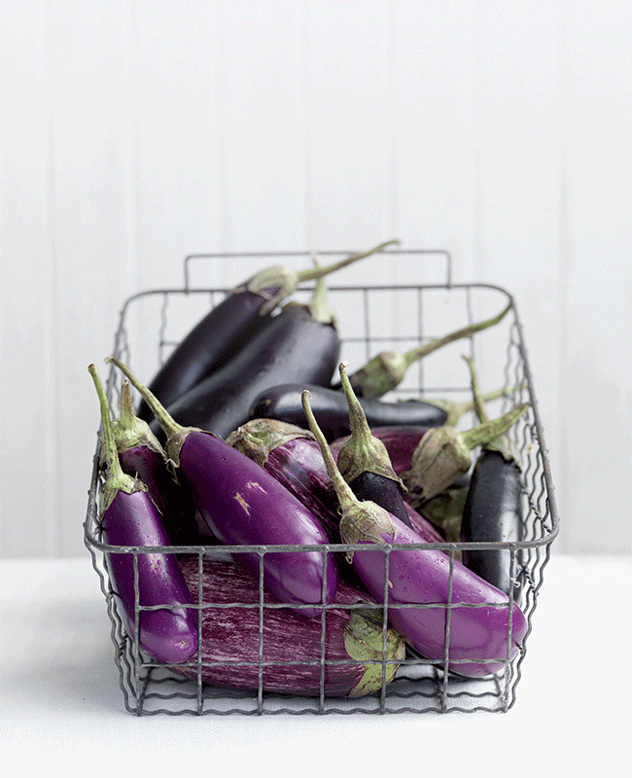In Season Eggplants. What is it, when its’ name denotes its shape and yet has many variations, eaten as a vegetable although technically a fruit, and called by a different name in nearly every culture in the world. It’s the old world vegetable – eggplant of course.
Did You Know?
Solanum melongena, also called melanzane, brinjal, aubergine, egg fruit or sometimes a garden egg, the “apple of madness”, or brown jolly. And that’s not even the varietal names included in that list. The popular term aubergine has been a slow transition from the Spanish name albadingena, proving that this is one of the oldest cultivated vegetables in our historical cookery books.
The eggplant is a member of the same plant family as tomatoes, capsicums, deadly nightshade and tobacco. The leaves of these plants are normally always toxic, yet the fruits of them priceless in our cuisines. Records show that the eggplant, which is easily transportable by the thin wafer like seeds, came from Southern Asia, through the mountains and up to the arable lands of the Persian gulf. When the moors invaded Europe they brought with them this garden plant as the biggest treasure they left behind.
Svelte purple to black shiny exterior, with curves better than a Jaguar S. Yet, the texture of the solid interior is the beautiful thing about an eggplant. Made up of an infinite amount of air pockets squished between the astringent cells. It is essentially a sponge. If you break those cells by salting or heating, it deflates those air pockets, releasing the bitter juices, leaving a slightly smoky perfumed, creamy, curd like pulp.
Nutrition Factor
The average eggplant is mostly water, over 90% in fact. The remaining cell structure is incredibly high in fibre and all vitamins and essential minerals, which often lends eggplants to be listed as one of the healthiest vegetables in our diet.
However, it is one of those polarising vegetables that can cause allergic reactions to some. The whole plant is high in histamines, which for those that suffer allergies, will probably react to and cause mouth and gut irritation. You will always find people love or loathe it, depending on their experiences.
How To Buy
Look for a smooth skin without dimples, wrinkling or bruising. The flesh should be firm and plump and well hydrated for optimum freshness. A good sign to the freshness of an eggplant is in the attached green stem. It should be vibrant green with a ridge down one side. Damage to the stem, will often mean damage within the fruit.
How To Grow
There are many varieties of eggplant seeds available, for all sizes and colours, and it is generally the best way to get the varieties you desire. Local growers will concentrate on the “black beauty” varietals giving us the large oval, and deep purple fruit we commonly find.
The key thing, is this plant does not like cold. The annual growth will be over the summer through the hottest times of the year, and will continue fruiting through a warm autumn. They have a long growing season, thriving in well-watered, loamy soils.
Many commercial crops are grown under cover of a greenhouse or polytunnel to reduce the risk of frost or cooler soil temperatures. While they thrive in the sub-tropical conditions, they don’t like humidity which will turn the leaves to mould.
How To Store
Being a subtropical fruit, an eggplant is best kept at a cool room temperature rather than in the fridge. Refrigeration will dehydrate the flesh rapidly and cause the fruit to become very bitter. For long term storing, eggplants are best to be turned into a spicy chutney or frozenas a pulp, but even then this will just bring out the bitterness. Buy small amounts often and use quickly.
Reduce Waste
The leaves and stems are toxic, so don’t try infusing them in your salts. Although eggplant skin can be made crisp and added to ground sea salt, for a smoky addition. By them fresh, but if they wrinkle they are still flavourful, just dehydrating, so cook with plenty of liquid. If they are mouldy, discard – but make sure to compost. There are a lot of
great trace elements to be re-invested back to the soil.
Cooking With Eggplants
The high water content in the cells of the eggplant contain astringent alkaloids, especially if the fruit is immature or old. This is where the common practise of salting comes in. The salt will break down the cells and cause them to excrete their bitter juices.
With more modern varieties of eggplant, the astringency is not so common, so often heating, through
microwaving, grilling, frying or roasting can be all that is needed. Avoid stainless steel utensils and non-aluminium pans, as these will discolour the flesh.
The skin is edible, but can be tough, so often is removed once grilled or roasted. If slices of eggplant are called for then the skin can be left on to keep the shape, and will break down in the cooking process.
The flesh can handle strong flavours like garlic, onion, paprika, chilli and the most tangy of olive oils all work well. Flouring of the slices will also help to achieve a crisp outside with a moist but firm inside once fried.
TIP –
The traditional technique of salting eggplants is to solve two problems – one to reduce bitterness of the fruit, especially in old fashioned varieties, or fruits that have been left too long on the parent plant.
The second reason, is because if you have ever tried to drizzle with olive oil, the flesh absorbs this oil like a sponge, and can reflect in the taste of the final dish. The salt collapses the cells to allow less oil to get in.
Enjoy eggplants with our favourite recipes:
Lamb with Smoky Eggplant and Pumpkin
Chargrilled Eggplant, Capsicum And Haloumi Stack With Pesto
Lamb, Eggplant & Feta Filo Spirals
Sichuan Chilli Eggplant & Soybeans
Drunken Roasted Eggplant & Ramen Noodle Salad
Looking for more seasonal recipes and tips?

Pick up the Spring issue of INSEASON for gardening advice, harvesting tips, delicious recipes and more.




